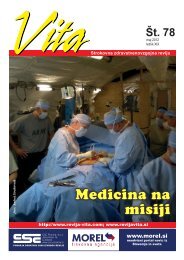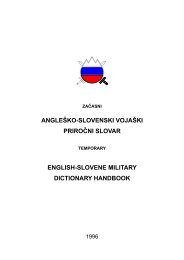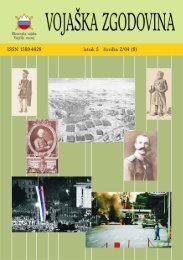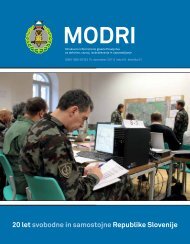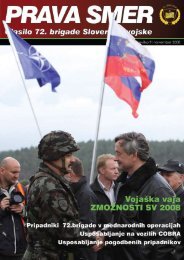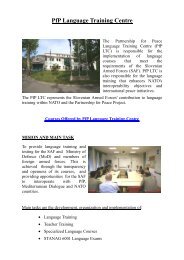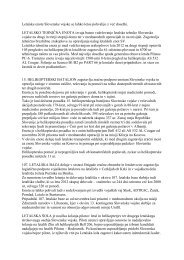Letnik 9/2, september 2007 - Slovenska vojska
Letnik 9/2, september 2007 - Slovenska vojska
Letnik 9/2, september 2007 - Slovenska vojska
Create successful ePaper yourself
Turn your PDF publications into a flip-book with our unique Google optimized e-Paper software.
NESLIŠNO OROŽJE: RAZVIJANJE OBVEŠČEVALNEGA SODELOVANJA V ...<br />
A number of recent examples can be cited to make the point, even if the<br />
information available is only partial due, largely, to the inherently secretive<br />
nature of intelligence operations. We might return to our opening example of how<br />
intelligence served as a silent weapon in the targeted killing (that is transparently<br />
what the episode represents) of al-Zarqawi, the savage and quite possibly<br />
psychopathic head of al-Qaeda in Iraq. Available information suggests that al-<br />
Zarqawi was the target of clandestine intelligence collection and subsequent<br />
surveillance by at least three countries, the United States, Iraq and Jordan. The<br />
Jordanians, in fact, may well have been the key player in the chain of events<br />
that led to identifying Zarqawi’s whereabouts. What is certain is that the USAF<br />
launched their bombing run on a specific structure believed to be serving as<br />
Zarqawi’s safe house and operations center of the moment. The tactical intelligence<br />
that lead to the successful killing of Zarqawi was clearly valid, precise and timely<br />
– in short, contained the required ingredients of actionable intelligence. It is quite<br />
possible that the information was obtained and confirmed by a combination of<br />
human sourcing (a spy) and technical intercept. Similarly, the widely publicized<br />
transfer of fourteen “high-value targets” from CIA detention centers to the<br />
Guantanamo facility in September, 2006 strikingly underlines the value of<br />
intelligence cooperation. As announced by President Bush on 6 September,<br />
2006, the al-Qaeda operatives captured 2 and incarcerated by CIA in so-called<br />
“secret prisons” were instrumental in providing valuable operational details that<br />
permitted the “rolling up” of other al-Qaeda devotees, including, notably, Khalid<br />
Sheik Mohammed and Abd al-Rahim al-Nashiri (The White House, 2006). Surely<br />
without serious dispute, lives were saved due to this (undoubtedly complex and<br />
costly) intelligence campaign. It is generally alleged that the network of “secret<br />
prisons” in which the terrorists were detained and interrogated required the<br />
cooperation of a number of foreign countries and their intelligence services. The<br />
information obtained seems to have been shared between services in at least some<br />
instances, notably with Australia. At any rate, the acquisition and exploitation<br />
of information from al-Qaeda prisoners permitted both intelligence sharing and<br />
direct action against high-value terrorist targets. Although popular focus is often<br />
on the boot that kicks down the door to a known terrorists’ room, the critical part<br />
of the counterterrorist equation is ensuring that the boot – SOCOM or other – is<br />
2<br />
For the identities of the fourteen terrorists transferred from CIA custody to the custody of the Department of<br />
Defense, see Office of the Director of National Intelligence http://www.odni.gov/announcements/content/detaineeBiographies.pdf.<br />
88



